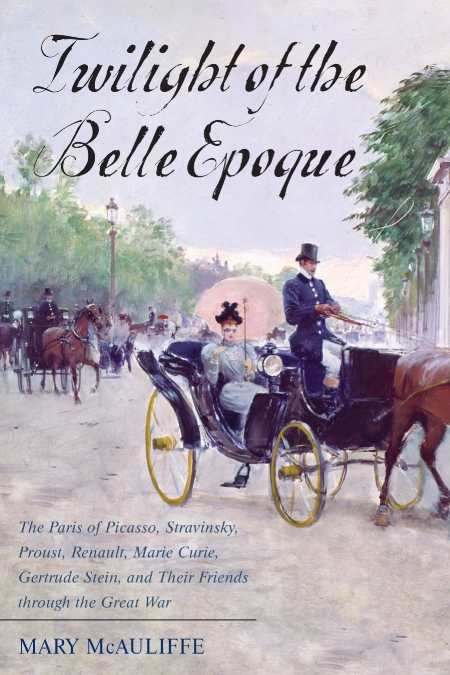
Twilight of the Belle Epoque
The Paris of Picasso, Stravinsky, Proust, Renault, Marie Curie, Gertrude Stein, and Their Friends through the Great War
Fascinating trivia about artists in turn-of-the-century Paris adds layers of insight to a time of growth and experimentation.
The famed Belle Époque was a period of artistic and cultural flowering in Paris that began in 1900 and ended with the First World War. True artistic colossi strode the planet. This is the focus of Mary McAuliffe’s panoramic study, Twilight of the Belle Epoque.
In virtually all areas of the arts, monumental figures came together in the City of Light at roughly the same time. Picasso, Cocteau, Stravinsky, Proust, Rodin, and Stein all contributed to a feverish atmosphere of growth and experimentation. At the same time, scientific innovators and entrepreneurs (Marie Curie, Louis Renault, André Citroën) revolutionized medicine, transportation, and related fields. It was a time, McAuliffe notes, “of extraordinary achievements in almost every field of endeavor, marked by a dizzying sequence of breakthroughs.”
The author of Dawn of the Belle Epoque and a lecturer at the Smithsonian Institute, McAuliffe is uniquely positioned to bring this crowded cast of characters to life. She does a thorough job of cataloging the wide range of artistic and scientific achievements while managing to also offer surprising tidbits that add texture to the narrative.
In 1902, for example, Émile Zola died in his home, an apparent victim of carbon-monoxide poisoning, although guinea pigs were left overnight in the house “to test the air” and survived the experience. Picasso, it seems, was fond of carrying around a rusty Browning revolver “and is credited with firing off several shots at the Lapin Agile in exasperation with several Germans intent on extracting aesthetic theories from him.” Proust obsessed over details for his multivolume masterpiece, visiting the countryside to study trees in bloom while “carefully keeping a closed car window between him and the cut branches he admired, to prevent them from bringing on an asthma attack.”
This was also the era of Nijinsky’s shocking performance in the ballet of Après-midi d’un faune (1912) and Stravinsky’s equally scandalous production of The Rites of Spring (1913). The premiere performance prompted boos and whistles from the audience, “along with raucous animal yelps.”
Twilight of the Belle Epoque contains a virtual embarrassment of riches and will be of most interest to readers seeking a highly detailed review of that era. Others, hoping for an analysis of how the earth-shaking cultural changes have reverberated to our modern times, might feel overwhelmed by the author’s exhaustive, chronological approach. Nevertheless, McAuliffe’s knowledge of and enthusiasm for this time is evident on every page.
Reviewed by
Lee Polevoi
Disclosure: This article is not an endorsement, but a review. The publisher of this book provided free copies of the book to have their book reviewed by a professional reviewer. No fee was paid by the publisher for this review. Foreword Reviews only recommends books that we love. Foreword Magazine, Inc. is disclosing this in accordance with the Federal Trade Commission’s 16 CFR, Part 255.
